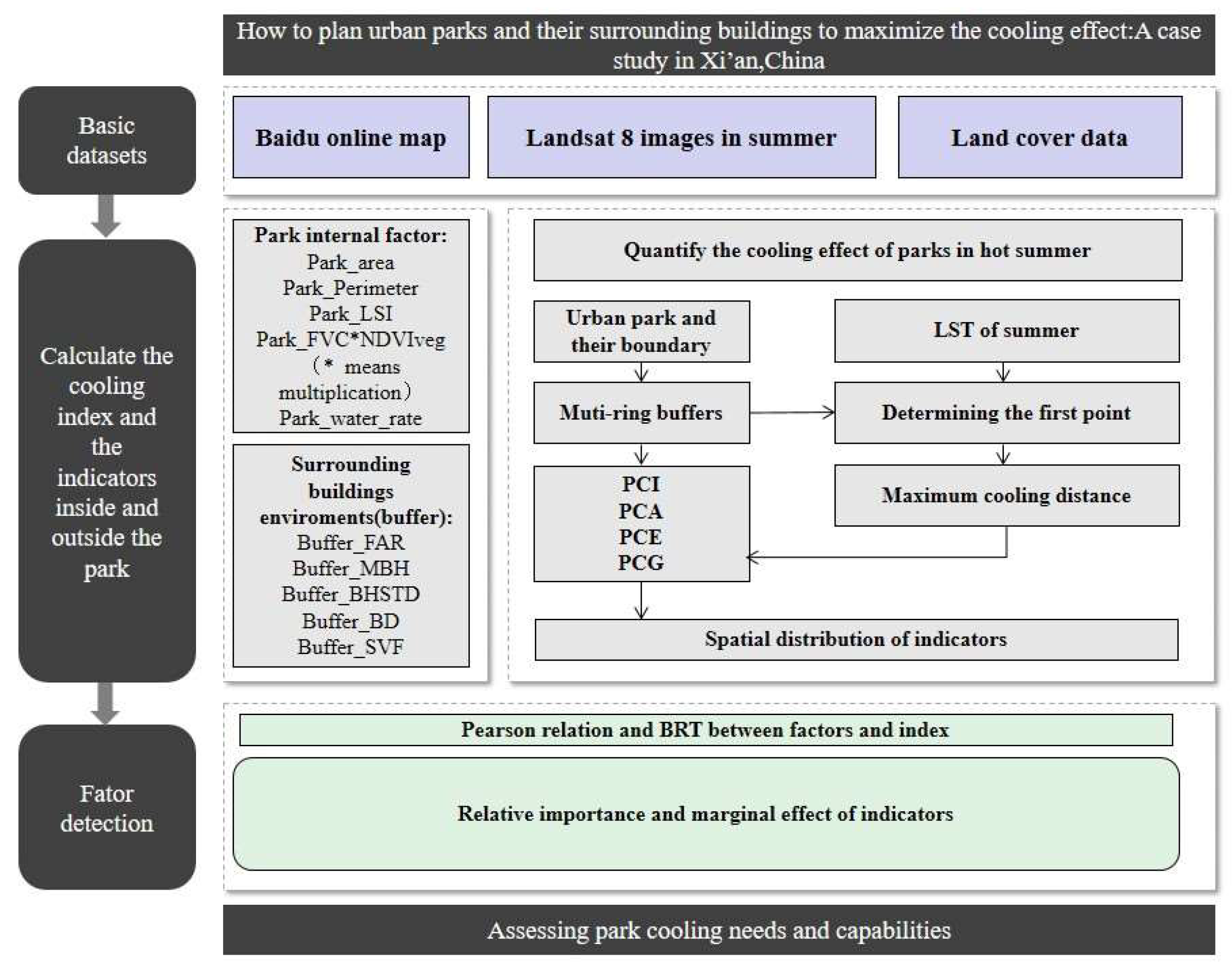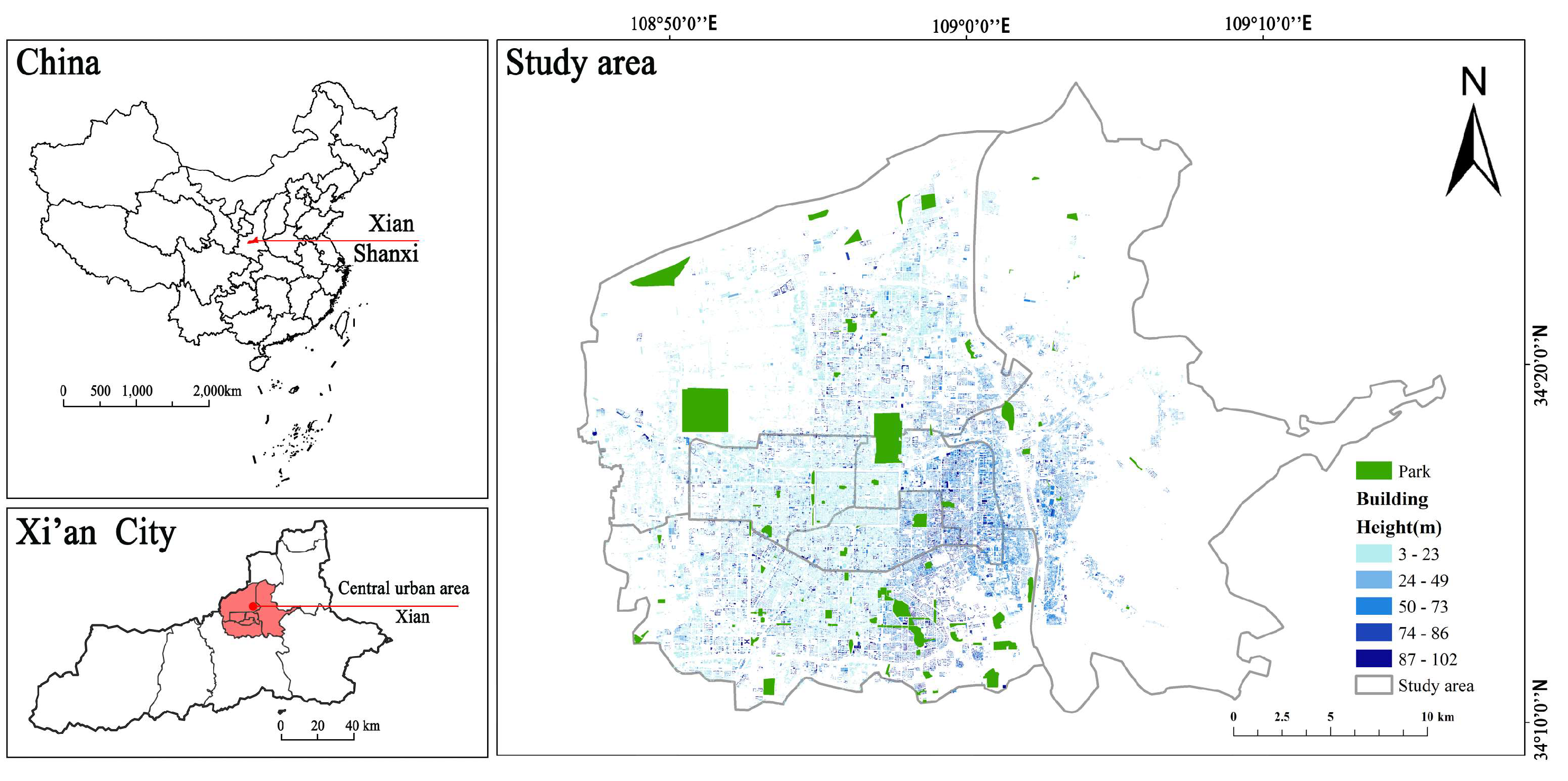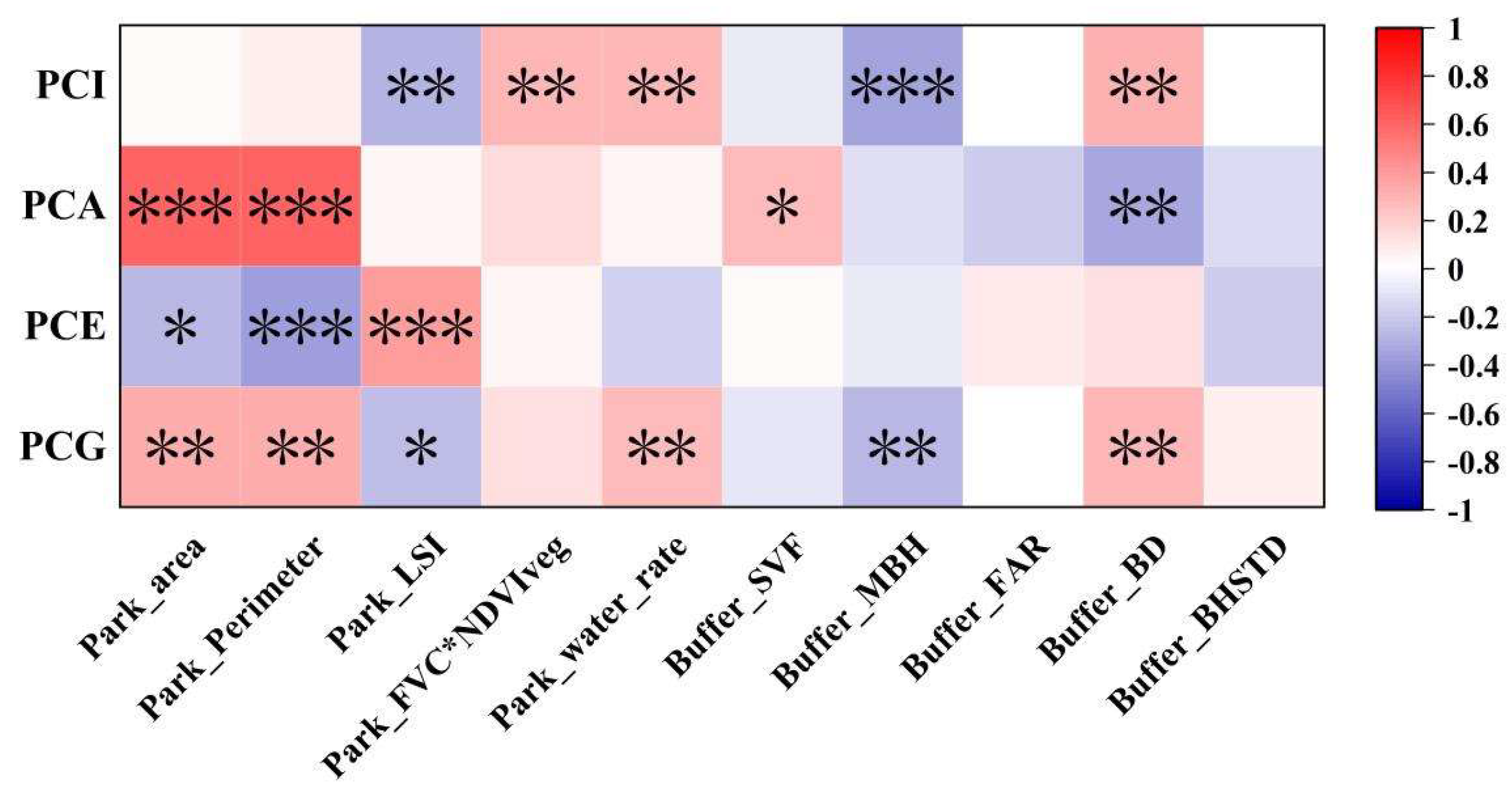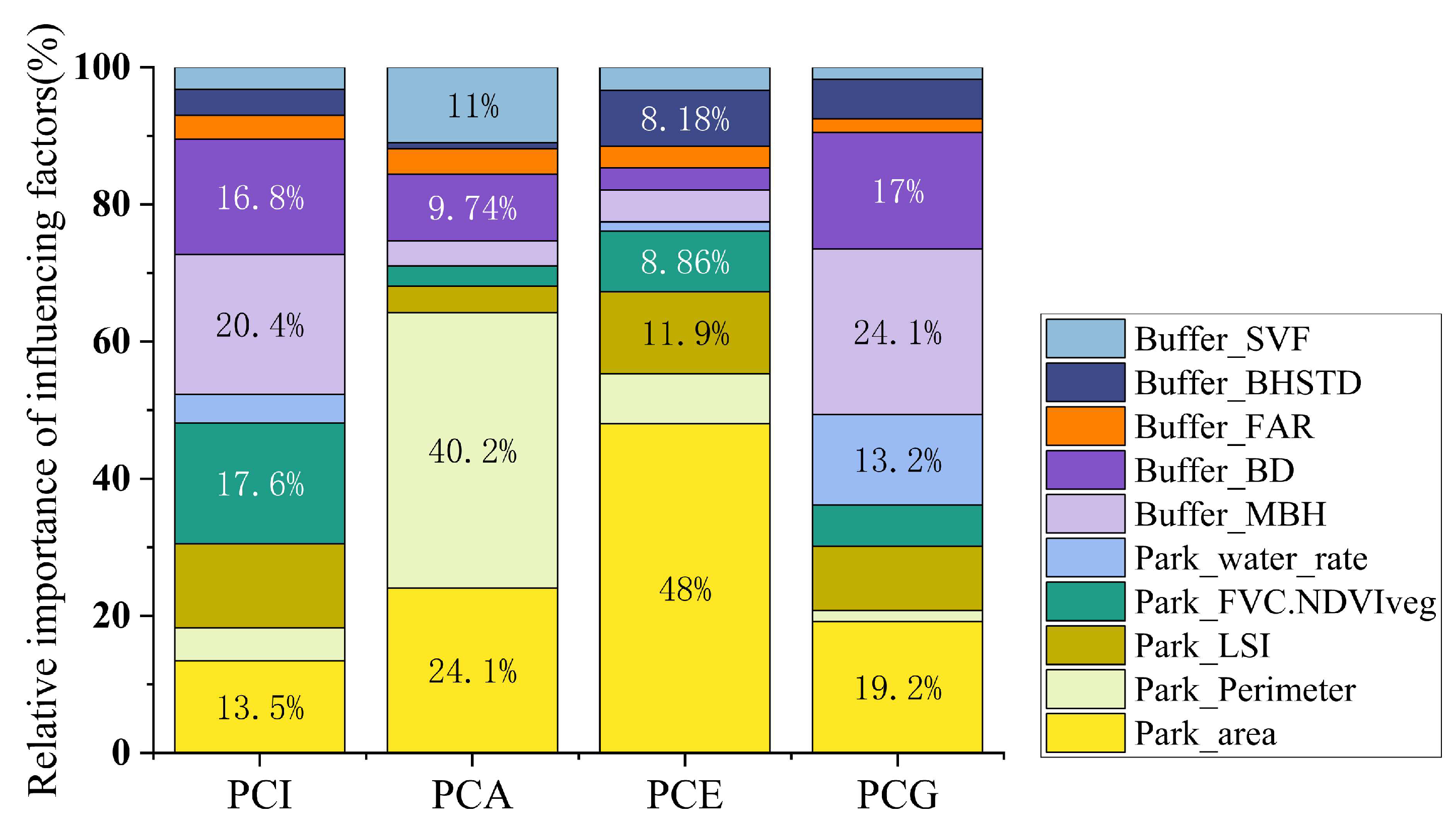How to Plan Urban Parks and the Surrounding Buildings to Maximize the Cooling Effect: A Case Study in Xi’an, China
Abstract
:1. Introduction
2. Materials and Methods
2.1. Research Framework and Data Resource
2.2. Study Area
2.3. Method
2.3.1. LST Retrieval
2.3.2. Quantification of Thermal Mitigation in Urban Parks
2.3.3. Factors Affecting Heat Mitigation in Urban Parks
2.3.4. Methods of Statistical Analysis
3. Results
3.1. Spatial Distribution of Thermal Mitigation Effects in Xi’an Urban Parks
3.2. Influencing Factors of Thermal Mitigation Effects in Xi’an Urban Parks
3.2.1. Urban Park Factors without Cooling Effects
3.2.2. Analysis of Drivers of Urban Parks with Thermal Mitigation Effects
3.3. Marginal Effects of Different Metrics on Thermal Mitigation in Xi’an Urban Parks
4. Discussion
4.1. Selection of Internal Park Metrics and External Building Metrics
4.2. Influence of Internal and External Factors on Thermal Mitigation in Urban Parks
4.3. How to Plan and Design Urban Parks and the Surrounding Built Environment Can Achieve the Best Thermal Mitigation Effect
4.4. Limitations and Future Research
5. Conclusions
Author Contributions
Funding
Data Availability Statement
Conflicts of Interest
References
- Ebi, K.L.; Capon, A.; Berry, P.; Broderick, C.; de Dear, R.; Havenith, G.; Honda, Y.; Kovats, R.S.; Ma, W.; Malik, A.; et al. Hot weather and heat extremes: Health risks. Lancet 2021, 398, 698–708. [Google Scholar] [CrossRef] [PubMed]
- Oke, T.R. The energetic basis of the urban heat island. Q. J. R. Meteorol. Soc. 1982, 108, 1–24. [Google Scholar] [CrossRef]
- Peng, J.; Xie, P.; Liu, Y.; Ma, J. Urban thermal environment dynamics and associated landscape pattern factors: A case study in the Beijing metropolitan region. Remote Sens. Environ. 2016, 173, 145–155. [Google Scholar] [CrossRef]
- Yu, Z.; Yang, G.; Zuo, S.; Jørgensen, G.; Koga, M.; Vejre, H. Critical review on the cooling effect of urban blue-green space: A threshold-size perspective. Urban For. Urban Green. 2020, 49, 126630. [Google Scholar] [CrossRef]
- Peng, J.; Dan, Y.; Qiao, R.; Liu, Y.; Dong, J.; Wu, J. How to quantify the cooling effect of urban parks? Linking maximum and accumulation perspectives. Remote Sens. Environ. 2021, 252, 112135. [Google Scholar] [CrossRef]
- Zhang, Q.; Zhou, D.; Xu, D.; Cheng, J.; Rogora, A. Influencing factors of the thermal environment of urban green space. Heliyon 2022, 8, e11559. [Google Scholar] [CrossRef] [PubMed]
- Xiao, Y.; Piao, Y.; Pan, C.; Lee, D.; Zhao, B. Using buffer analysis to determine urban park cooling intensity: Five estimation methods for Nanjing, China. Sci. Total Environ. 2023, 868, 161463. [Google Scholar] [CrossRef] [PubMed]
- Chen, X.; Su, Y.; Li, D.; Huang, G.; Chen, W.; Chen, S. Study on the cooling effects of urban parks on surrounding environments using Landsat TM data: A case study in Guangzhou, southern China. Int. J. Remote Sens. 2012, 33, 5889–5914. [Google Scholar] [CrossRef]
- Feyisa, G.L.; Dons, K.; Meilby, H. Efficiency of parks in mitigating urban heat island effect: An example from Addis Ababa. Landsc. Urban Plan. 2014, 123, 87–95. [Google Scholar] [CrossRef]
- Gao, Y.; Zhao, J.; Han, L. Quantifying the nonlinear relationship between block morphology and the surrounding thermal environment using random forest method. Sustain. Cities Soc. 2023, 91, 104443. [Google Scholar] [CrossRef]
- Liao, W.; Guldmann, J.-M.; Hu, L.; Cao, Q.; Gan, D.; Li, X. Linking urban park cool island effects to the landscape patterns inside and outside the park: A simultaneous equation modeling approach. Landsc. Urban Plan. 2023, 232, 104681. [Google Scholar] [CrossRef]
- Han, D.; Xu, X.; Qiao, Z.; Wang, F.; Cai, H.; An, H.; Jia, K.; Liu, Y.; Sun, Z.; Wang, S.; et al. The roles of surrounding 2D/3D landscapes in park cooling effect: Analysis from extreme hot and normal weather perspectives. Build. Environ. 2023, 231, 110053. [Google Scholar] [CrossRef]
- Founda, D.; Santamouris, M. Synergies between Urban Heat Island and Heat Waves in Athens (Greece), during an extremely hot summer (2012). Sci. Rep. 2017, 7, 10973. [Google Scholar] [CrossRef] [PubMed]
- Yang, Y.; Zhou, D.; Wang, Y.; Ma, D.; Chen, W.; Xu, D.; Zhu, Z. Economical and outdoor thermal comfort analysis of greening in multistory residential areas in Xi’an. Sustain. Cities Soc. 2019, 51, 101730. [Google Scholar] [CrossRef]
- Zhao, C.; Fu, G.; Liu, X.; Fu, F. Urban planning indicators, morphology and climate indicators–A case study for a north-south transect of Beijing, China. Build. Environ. 2011, 46, 1174–1183. [Google Scholar] [CrossRef]
- Chen, M.; Jia, W.; Yan, L.; Du, C.; Wang, K. Quantification and mapping cooling effect and its accessibility of urban parks in an extreme heat event in a megacity. J. Clean. Prod. 2022, 334, 130252. [Google Scholar] [CrossRef]
- Du, C.; Jia, W.; Chen, M.; Yan, L.; Wang, K. How can urban parks be planned to maximize cooling effect in hot extremes? Linking maximum and accumulative perspectives. J. Environ. Manag. 2022, 317, 115346. [Google Scholar] [CrossRef] [PubMed]
- Zhang, Q.; Zhou, D.; Xu, D.; Rogora, A. Correlation between cooling effect of green space and surrounding urban spatial form: Evidence from 36 urban green spaces. Build. Environ. 2022, 222, 109375. [Google Scholar] [CrossRef]
- Gao, Z.; Zaitchik, B.F.; Hou, Y.; Chen, W. Toward park design optimization to mitigate the urban heat island: Assessment of the cooling effect in five U.S. cities. Sustain. Cities Soc. 2022, 81, 103870. [Google Scholar] [CrossRef]
- Liang, Z.; Li, Z.; Fan, Z. Seasonal impacts of built environment and its interactions on urban park cooling effects in Nanjing, China. Build. Environ. 2023, 242, 110580. [Google Scholar] [CrossRef]
- Bernard, J.; Rodler, A.; Morille, B.; Zhang, X. How to Design a Park and Its Surrounding Urban Morphology to Optimize the Spreading of Cool Air? Climate 2018, 6, 10. [Google Scholar] [CrossRef]
- Lin, Z.; Xu, H.; Yao, X.; Yang, C.; Yang, L. Exploring the relationship between thermal environmental factors and land surface temperature of a “furnace city” based on local climate zones. Build. Environ. 2023, 243, 110732. [Google Scholar] [CrossRef]
- Li, L.; Zha, Y. Population exposure to extreme heat in China: Frequency, intensity, duration and temporal trends. Sustain. Cities Soc. 2020, 60, 102282. [Google Scholar] [CrossRef]
- Yang, C.; Yan, F.; Zhang, S. Comparison of land surface and air temperatures for quantifying summer and winter urban heat island in a snow climate city. J. Environ. Manag. 2020, 265, 110563. [Google Scholar] [CrossRef] [PubMed]
- Kim, G.-H.; Lee, Y.-G.; Kim, J.; Choi, H.-W.; Kim, B.-J. Analysis of the Cooling Effects in Urban Green Areas using the Landsat 8 Satellite Data. Korean J. Remote Sens. 2018, 34, 167–178. [Google Scholar] [CrossRef]
- Xu, H.; Shi, T.; Wang, M.; Fang, C.; Lin, Z. Predicting effect of forthcoming population growth–induced impervious surface increase on regional thermal environment: Xiong’an New Area, North China. Build. Environ. 2018, 136, 98–106. [Google Scholar] [CrossRef]
- Huang, X.; Wang, Y. Investigating the effects of 3D urban morphology on the surface urban heat island effect in urban functional zones by using high-resolution remote sensing data: A case study of Wuhan, Central China. ISPRS J. Photogramm. Remote Sens. 2019, 152, 119–131. [Google Scholar] [CrossRef]
- Ministry of Housing and Urban-Rural Development of the People’s Republic of China (MOHURD). Urban Green Space Classification Standard (CJJ/T 85-2017); MOHURD: Beijing, China, 2017. [Google Scholar]
- Liu, A.; Ma, X.; Du, M.; Su, M.; Hong, B. The cooling intensity of green infrastructure in local climate zones: A comparative study in China’s cold region. Urban Clim. 2023, 51, 101631. [Google Scholar] [CrossRef]
- McElroy, S.; Schwarz, L.; Green, H.; Corcos, I.; Guirguis, K.; Gershunov, A.; Benmarhnia, T. Defining heat waves and extreme heat events using sub-regional meteorological data to maximize benefits of early warning systems to population health. Sci. Total Environ. 2020, 721, 137678. [Google Scholar] [CrossRef]
- Barsi, J.A.; Schott, J.R.; Palluconi, F.D.; Hook, S.J. Validation of a web-based atmospheric correction tool for single thermal band instruments. In Proceedings of the Optics and Photonics 2005, Earth Observing Systems X, San Diego, CA, USA, 31 July–4 August 2005; SPIE: San Francisco, CA, USA, 2005; Volume 5882, p. 58820E. [Google Scholar] [CrossRef]
- Jiang, L.; Liu, S.; Liu, C.; Feng, Y. How do urban spatial patterns influence the river cooling effect? A case study of the Huangpu Riverfront in Shanghai, China. Sustain. Cities Soc. 2021, 69, 102835. [Google Scholar] [CrossRef]
- Yu, Z.; Xu, S.; Zhang, Y.; Jørgensen, G.; Vejre, H. Strong contributions of local background climate to the cooling effect of urban green vegetation. Sci. Rep. 2018, 8, 6798. [Google Scholar] [CrossRef] [PubMed]
- Aram, F.; Solgi, E.; Higueras García, E.; Mosavi, A.; Várkonyi-Kóczy, R. The Cooling Effect of Large-Scale Urban Parks on Surrounding Area Thermal Comfort. Energies 2019, 12, 3904. [Google Scholar] [CrossRef]
- Li, Z.; Wang, Z.; Wen, D.; Wu, L. How urban parks and their surrounding buildings affect seasonal land surface temperature: A case study in Beijing, China. Urban For. Urban Green. 2023, 87, 128047. [Google Scholar] [CrossRef]
- Yuan, B.; Zhou, L.; Dang, X.; Sun, D.; Hu, F.; Mu, H. Separate and combined effects of 3D building features and urban green space on land surface temperature. J. Environ. Manag. 2021, 295, 113116. [Google Scholar] [CrossRef] [PubMed]
- Friedman, J.H. Greedy function approximation: A gradient boosting machine. Ann. Stat. 2001, 29, 1189–1232. [Google Scholar] [CrossRef]
- He, B.-J.; Ding, L.; Prasad, D. Enhancing urban ventilation performance through the development of precinct ventilation zones: A case study based on the Greater Sydney, Australia. Sustain. Cities Soc. 2019, 47, 101472. [Google Scholar] [CrossRef]
- Cao, X.; Onishi, A.; Chen, J.; Imura, H. Quantifying the cool island intensity of urban parks using ASTER and IKONOS data. Landsc. Urban Plan. 2010, 96, 224–231. [Google Scholar] [CrossRef]
- Zhao, L.; Lee, X.; Smith, R.; Oleson, K. Strong contributions of local background climate to urban heat islands. Nature 2014, 511, 216–219. [Google Scholar] [CrossRef] [PubMed]
- Lu, J.; Li, C.; Yang, Y.; Zhang, X.-H.; Jin, M. Quantitative evaluation of urban park cool island factors in mountain city. J. Cent. South Univ. Technol. 2012, 19, 1657–1662. [Google Scholar] [CrossRef]
- Xiao, Y.; Piao, Y.; Wei, W.; Pan, C.; Lee, D.; Zhao, B. A comprehensive framework of cooling effect-accessibility-urban development to assessing and planning park cooling services. Sustain. Cities Soc. 2023, 98, 104817. [Google Scholar] [CrossRef]
- Shi, M.; Chen, M.; Jia, W.; Du, C.; Wang, Y. Cooling effect and cooling accessibility of urban parks during hot summers in China’s largest sustainability experiment. Sustain. Cities Soc. 2023, 93, 104519. [Google Scholar] [CrossRef]
- Meng, Q.; Gao, J.; Zhang, L.; Hu, X.; Qian, J.; Jancsó, T. Coupled cooling effects between urban parks and surrounding building morphologies based on the microclimate evaluation framework integrating remote sensing data. Sustain. Cities Soc. 2024, 102, 105235. [Google Scholar] [CrossRef]







| Data | Date | Resolution | Source |
|---|---|---|---|
| Landsat 8 OIL | 2 August 2021 | 30 m | https://www.gscloud.cn (accessed on 2 August 2021) |
| Building dataset | 2021 | Vector data | https://lbsyun.baidu.com (accessed on 5 May 2021) |
| Park data | 2020 | Vector data | List of parks in Xi’an City Xi’an Garden and Forestry Bureau |
| Meteorological data | 2021 | Vector data | Xi’an Meteorological Bureau |
| Land cover data | 2021 | Vector data | Changed data of the Third Land Survey of Xi’an Municipality |
| Administrative boundary | 2021 | Vector data | National Geomatics Center of China |
| POI | 2023 | Vector data | https://www.openstreetmap.org (accessed on 8 March 2023) |
| Categories of Indexes | Impact Factors | Description |
|---|---|---|
| Landscape composition character of urban parks | Park_area | Area of the urban park |
| Park_Perimeter | Perimeter of the urban park | |
| Park_LSI | Degree of landscape shape complexity | |
| Park_FVC*NDVIveg() | Consideration is also given to quantifying the vegetation cover and greenness of the park, with NDVIveg as the vegetated area | |
| Park_water_rate | Percentage of park water bodies | |
| External environment factors of urban parks | Buffer_FAR | Building floor area ratio (FAR) within the park perimeter buffer zone |
| Buffer_MBH | Mean building height within the park perimeter buffer zone | |
| Buffer_BHSTD | Hi is the height of building i; Hmean is the average height of all the average heights of buildings; n is the number of buildings; the standard deviation of the building height | |
| Buffer_BD | Proportion of building footprint in the buffer zone to total buffer zone area | |
| Buffer_SVF | Sky view factor, which indicates the amount of sky visible from the ground at a given location and refers to the proportion of the sky that is not obstructed by surrounding buildings |
| Urban Morphology Indicator | VIF | |||
|---|---|---|---|---|
| PCI | PCA | PCG | PCE | |
| Park_area | 4.544 | 4.544 | 4.544 | 4.544 |
| Park_Perimeter | 4.725 | 4.725 | 4.725 | 4.725 |
| Park_LSI | 1.293 | 1.293 | 1.293 | 1.293 |
| Park_FVC*NDVIveg (* means multiplication) | 1.082 | 1.082 | 1.082 | 1.082 |
| Park_water_rate | 1.273 | 1.273 | 1.273 | 1.273 |
| Buffer_FAR | 1.524 | 1.524 | 1.524 | 1.524 |
| Buffer_MBH | 1.775 | 1.775 | 1.775 | 1.775 |
| Buffer_BHSTD | 1.971 | 1.971 | 1.971 | 1.971 |
| Buffer_BD | 1.938 | 1.938 | 1.938 | 1.938 |
| Buffer_SVF | 1.089 | 1.089 | 1.089 | 1.089 |
Disclaimer/Publisher’s Note: The statements, opinions and data contained in all publications are solely those of the individual author(s) and contributor(s) and not of MDPI and/or the editor(s). MDPI and/or the editor(s) disclaim responsibility for any injury to people or property resulting from any ideas, methods, instructions or products referred to in the content. |
© 2024 by the authors. Licensee MDPI, Basel, Switzerland. This article is an open access article distributed under the terms and conditions of the Creative Commons Attribution (CC BY) license (https://creativecommons.org/licenses/by/4.0/).
Share and Cite
Wu, T.; Wang, X.; Xuan, L.; Yan, Z.; Wang, C.; Du, C.; Su, Y.; Duan, J.; Yu, K. How to Plan Urban Parks and the Surrounding Buildings to Maximize the Cooling Effect: A Case Study in Xi’an, China. Land 2024, 13, 1117. https://doi.org/10.3390/land13081117
Wu T, Wang X, Xuan L, Yan Z, Wang C, Du C, Su Y, Duan J, Yu K. How to Plan Urban Parks and the Surrounding Buildings to Maximize the Cooling Effect: A Case Study in Xi’an, China. Land. 2024; 13(8):1117. https://doi.org/10.3390/land13081117
Chicago/Turabian StyleWu, Tianji, Xuhui Wang, Le Xuan, Zhaoyang Yan, Chao Wang, Chunlei Du, Yutong Su, Jingya Duan, and Kanhua Yu. 2024. "How to Plan Urban Parks and the Surrounding Buildings to Maximize the Cooling Effect: A Case Study in Xi’an, China" Land 13, no. 8: 1117. https://doi.org/10.3390/land13081117
APA StyleWu, T., Wang, X., Xuan, L., Yan, Z., Wang, C., Du, C., Su, Y., Duan, J., & Yu, K. (2024). How to Plan Urban Parks and the Surrounding Buildings to Maximize the Cooling Effect: A Case Study in Xi’an, China. Land, 13(8), 1117. https://doi.org/10.3390/land13081117





